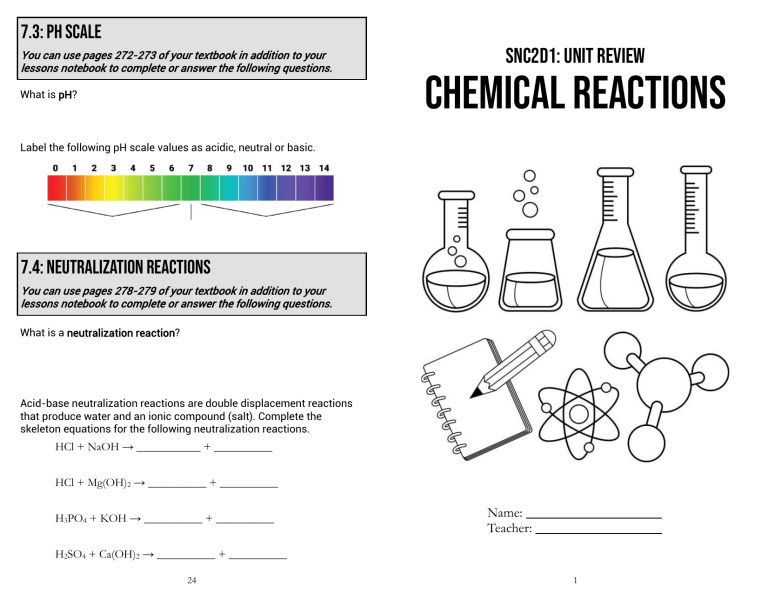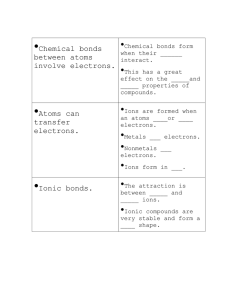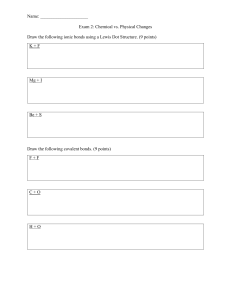
7.3: pH Scale You can use pages 272-273 of your textbook in addition to your lessons notebook to complete or answer the following questions. What is pH? Snc2d1: unit review Chemical reactions Label the following pH scale values as acidic, neutral or basic. 7.4: Neutralization Reactions You can use pages 278-279 of your textbook in addition to your lessons notebook to complete or answer the following questions. What is a neutralization reaction? Acid-base neutralization reactions are double displacement reactions that produce water and an ionic compound (salt). Complete the skeleton equations for the following neutralization reactions. HCl + NaOH → ___________ + __________ HCl + Mg(OH)2 → __________ + __________ H3PO4 + KOH → __________ + __________ Name: Teacher: H2SO4 + Ca(OH)2 → __________ + __________ 24 1 5.1: properties and changes You can use pages 175-178 of your textbook in addition to your lessons notebook to complete or answer the following questions. Differentiate between physical and chemical properties and give an example of each. Physical Property Chemical Property 7.2: Properties, Names and Formulas of Acids and Bases You can use pages 268-271 of your textbook in addition to your lessons notebook to complete or answer the following questions. Complete the following table to summarize the properties of acids and bases. Property Acids Bases Ion released in water Definition Electrical Conductivity Reacts with metals? Example Reacts with carbonates? Taste Differentiate between physical and chemical changes and give an example of each. Physical Change Chemical Change Reaction with blue litmus paper Reaction with red litmus paper pH Definition Write three examples of chemical formulas for the following: Compound Example Example Chemical Formulas Binary Acids Oxyacids Bases 2 23 Identifying types of reactions 5.4: Patterns and the Periodic Table Use your lessons notebook to complete or answer the following questions. You can use pages 184-187 of your textbook in addition to your lessons notebook to complete or answer the following questions. Identify the following reactions as synthesis, decomposition, single displacement, double displacement or combustion. What are rows on the periodic table called? What are columns on the periodic table called? How many valence electrons will the following elements have? An element in Group 1 An element in Group 2 An element in Group 13 An element in Group 14 An element in Group 15 An element in Group 16 An element in Group 17 An element in Group 18 Balance and identify the following reactions as synthesis, decomposition, single displacement, double displacement or combustion. How many orbitals or shells will the following elements have? An element in Period 1 An element in Period 2 An element in Period 3 An element in Period 4 An element in Period 5 Read Atomic Structure on page 185 of your textbook to complete the missing blanks. The elements of the periodic table are arranged in order of increasing . Atoms are electrically , with equal numbers of protons and neutrons. 22 3 Colour in the metals, nonmetals and metalloids on the following periodic table. 6.9: Types of Chemical Reactions: Combustion You can use pages 248-250 of your textbook in addition to your lessons notebook to complete or answer the following questions. What is a combustion reaction? What is a complete combustion reaction? What are the only products of complete combustion? Write the general pattern or equation for a complete combustion reaction. Refer to the periodic table to write the symbols for the following elements: • The halogen of the second period • The alkaline earth metal of the fifth period • The noble gas with the smallest atomic # • The nonmetal in the fifth period with seven valence electrons • The alkali metal of the fourth period • The metal of the third period with three valence electrons • The noble gas of the first period 4 What is an incomplete combustion reaction? In addition to CO2 and H2O, what other products may be formed in an incomplete combustion reaction? 21 6.5—6.6: Types of Chemical Reactions: Synthesis, decomposition, Single and Double Displacement You can use pages 237-243 of your textbook in addition to your lessons notebook to complete or answer the following questions. What is a synthesis reaction? Write the general pattern or equation for a synthesis reaction. Complete the chart on subatomic particles. Subatomic Particle Electrical Charge Location in Atom Symbol Proton Electron Neutron How do you calculate the number of each subatomic particle in an atom? No. of p+ = What is a decomposition reaction? Write the general pattern or equation for a synthesis reaction. No. of e─ = No. of n0 = Complete the following for the metal element, Aluminum, Al. What is a single displacement reaction? Write the general pattern or equation for a synthesis reaction. Atomic Number Mass Number Atomic Notation No. of protons Bohr Diagram of Al Lewis Diagram of Al What is a double displacement reaction? Write the general pattern or equation for a synthesis reaction. 20 No. of electrons 5 No. of neutrons Complete the following for the nonmetal element, Phosphorus, P. Atomic Number Mass Number Atomic Notation No. of protons No. of electrons No. of neutrons 6.4: Information in Chemical Reactions You can use pages 233-236 of your textbook in addition to your lessons notebook to complete or answer the following questions. Balance the following reactions if they are not already balanced. ____ Ca + ____Cl2 → ____ CaCl2 Bohr Diagram of P Lewis Diagram of P ____ K + ____ Br2 → ____ KBr ____ H2O2 → ____ H2O + ____ O2 ____ Na + ____ O2 → ____ Na2O ____ NH4OH + ____ HBr → ____H2O + ____NH4Br 5.5: ATOMS and IONS ____ CaSO4 + ____ KOH → ____ Ca(OH)2 + ____K2SO4 You can use pages 188-191 of your textbook in addition to your lessons notebook to complete or answer the following questions. ____ Ba + ____ HNO3 → ____H2 + ____Ba(NO3)2 What is an ion? ____ H3PO4 + ____NaOH → ____H2O + ____Na3PO4 ____ C3H8 + ____O2 → ____CO2 + ____H2O Differentiate between cations vs anions. Cations Forms from METAL or NONMETAL atoms? ____ Al4C3 + ____H2O → ____CH4 + Al(OH)3 Anions ____ FeBr3 + ____Na → ____Fe + ____ NaBr ____ Fe + ____H2SO4 → ____ H2 + ____ Fe2(SO4)3 Results from LOSS or GAIN of electrons? ____ C2H6 + ____ O2 → ____CO2 + ____ H2O Overall Positive or Negative Charge? 6 19 Why do ions form? 6.3: Conserving Mass in Chemical Reactions You can use pages 230-231 of your textbook in addition to your lessons notebook to complete or answer the following questions. What is the Law of Conservation of Mass? Complete the following table using the information provided. The first two rows are completed as examples. Use the Law of Conservation of Mass to determine the missing mass values for different reactions of HCl with NaOH. HCl + NaOH → H2O + 50 g + 65 g → 100 g + 20 g + → 30 g + 15 g 30 g + + 14 g 40 g → Element No. of p+ No. of e─ Ionic Charge Ion Symbol Sodium 11 10 1+ Na1+ Oxygen 8 10 2─ O2- 20 NaCl 18 Aluminum Determine the number of atoms in each of the following compounds. 3 Ba(NO3)2 Element # of Atoms 1─ 13 P3- Counting Atoms Use your lessons notebook to complete or answer the following questions. Ca2+ 35 36 56 54 Read Naming Ions on page 190 of your textbook to complete the missing blanks. The name of a positive ion is _____________________ the name of the _________________. The name of a negative ion is determined by ______________________ to the stem of the name. Name the following ions. 2+ 2 Fe2(SO4)3 Element # of Atoms • Mg ion 1- ion 1+ ion 3- ion • Cl • Li • N 18 7 What ionic charge will elements in the following groups generally form? An element in Group 1 6.1: Describing Chemical Reactions You can use pages 225-226 of your textbook in addition to your lessons notebook to complete or answer the following questions. An element in Group 2 An element in Group 13 What are reactants? An element in Group 14 An element in Group 15 An element in Group 16 What are products? An element in Group 17 An element in Group 18 The following Bohr diagrams are for the neutral atoms of each element. Draw the Bohr and Lewis diagram for the ion that each element will form. Don’t forget the square brackets and the ionic charge. Bohr Diagram of Ion Lewis Diagram of Ion Write word and skeleton equations for the following descriptions of chemical reactions. Aluminum metal reacts with oxygen from the air to produce a protective coating called aluminum oxide. Word Equation: Skeleton Equation: Silver nitrate reacts with sodium chloride to produce silver chloride and sodium nitrate. Word Equation: Bohr Diagram of Ion Lewis Diagram of Ion Skeleton Equation: Propane (C3H8) reacts with oxygen to produce water and carbon dioxide. Word Equation: Skeleton Equation: 8 17 Drawing MOLECULAR Compounds 5.6: Ionic Compounds Use your lessons notebook to complete or answer the following questions. You can use pages 192-195 of your textbook in addition to your lessons notebook to complete or answer the following questions. When drawing the formation of molecular compounds, remember: 1. Determine the correct formula first to draw the right number of atoms. 2. Check your Lewis Diagrams for the correct number of valence electrons. 3. Circle pairs of electrons to show the sharing of electrons between nonmetal atoms. One electron on one atom paired with one electron on another atom. 4. Re-write circled pairs as a single line to show the covalent bond between atoms. Draw the formation of the following molecular compounds. Read Making Ionic Compounds from Elements on page 192 of your textbook to complete the missing blanks. The nonmetal atoms take electrons from the metal atoms. This electron _______________ is possible because the ________________________ of its outermost _______________ is __________. At the same time, the nonmetal ______________ the metal’s electrons _______________. The resulting ________ all have the same, _____________, filled outer electron _____________________ as the nearest ___________________. What is an ionic compound? Nitrogen trihydride What is an ionic bond? H2CO List at least four (4) properties of ionic compounds. 16 9 5.7: Names and Formulas of Ionic Compounds Write down some rules to help you name molecular compounds You can use pages 196-200 of your textbook in addition to your lessons notebook to complete or answer the following questions. Write down some rules to help you name binary ionic compounds. Name the following molecular compounds. Formula Name NI3 CCl4 Name the following binary ionic compounds. Formula Name P2O5 AlBr3 N2O3 NaCl SO2 Ba3P2 P4S9 MgS CO Write down some rules to help you name ionic compounds containing transition metals. Write the formulas for the following molecular compounds Name Formula Nitrogen monoxide Sulfur hexafluoride Dihydrogen monoxide Name the following ionic compounds containing transition metals. Formula Name Iodine heptafluoride Phosphorus trichloride PbCl2 Disulfur dichloride Fe2O3 Dinitrogen tetroxide CuF2 SnS 10 15 5.8: Molecules and Covalent Bonding An easy shortcut for determining the formula of ionic compounds is the Crisscross Method. Use it to determine the formulas of the following: You can use pages 206-209 of your textbook in addition to your lessons notebook to complete or answer the following questions. Name Formula Calcium chloride What is a molecular compound? Iron (II) bromide Aluminum oxide Manganese (IV) sulfide Magnesium iodide What is a covalent bond? Tin (IV) chloride Lithium nitride Copper (I) fluoride What is a molecule? 5.8: Polyatomic Ions You can use pages 202-205 of your textbook in addition to your lessons notebook to complete or answer the following questions. What is a polyatomic ion? What is a diatomic molecule? Which elements exist as diatomic molecules? (See Table 1 on page 208) Write down the formulas and charges of the following common polyatomic ions. • Ammonium ion • Carbonate ion • Chlorate ion • Hydroxide ion • Nitrate ion • Phosphate ion • Sulfate ion 14 11 Write down some rules to help you name ionic compounds containing polyatomic ions. Drawing Ionic Compounds Use your lessons notebook to complete or answer the following questions. When drawing the formation of ionic compounds, remember: Name the following ionic compounds containing polyatomic ions. Formula Name 1. Determine the correct formula first to draw the right number of atoms. 2. Check your Lewis Diagrams for the correct number of valence electrons. 3. Use arrows to show the transfer of electrons from metal atoms o nonmetal atoms. 4. Make sure your final ions include square brackets, the ionic charge and any necessary subscripts. KNO3 Ca(OH)2 CaCO3 Draw the formation of the following ionic compounds. (NH4)PO4 Fe(NO3)3 Aluminum nitride Cu(ClO3)2 CuSO4 Write the formulas for the following ionic compounds containing polyatomic ions. Remember that polyatomic ions need to be within brackets if they are given a subscript greater than 1. Name Formula Magnesium chloride Potassium nitrate Tin (II) phosphate Barium sulfate Copper (II) nitrate Aluminum sulfate Lead (II) chlorate Ammonium nitrate 12 13




